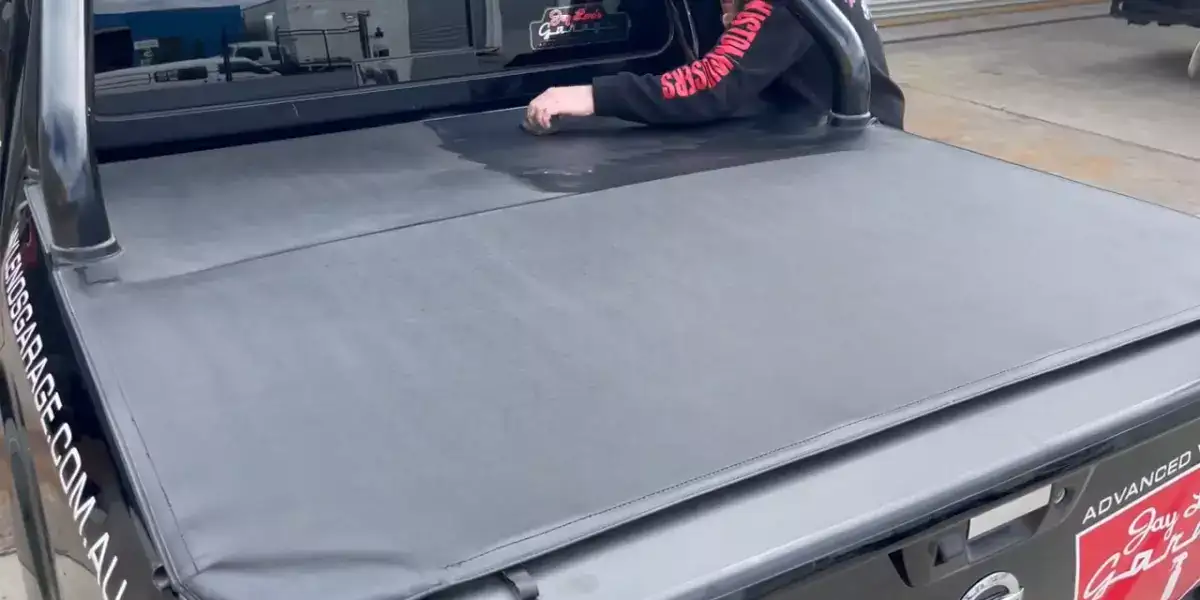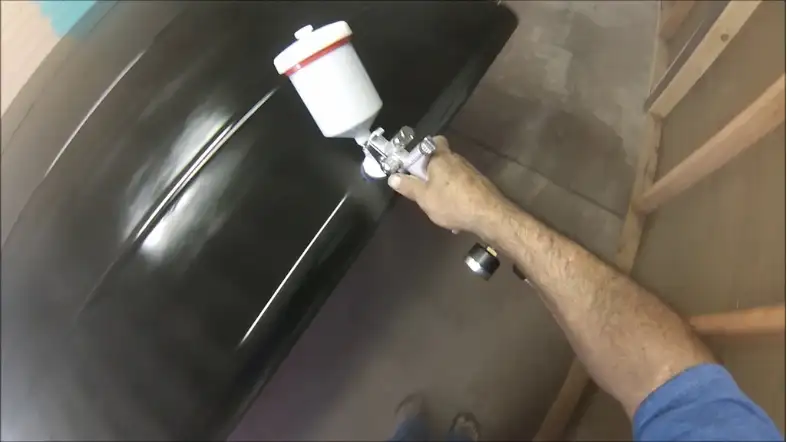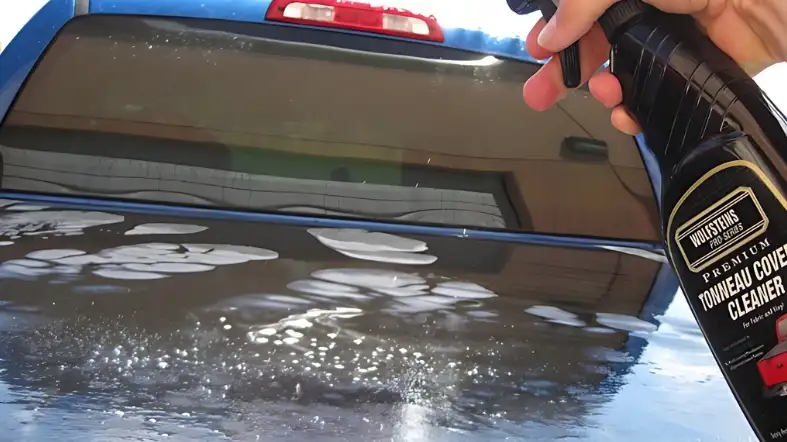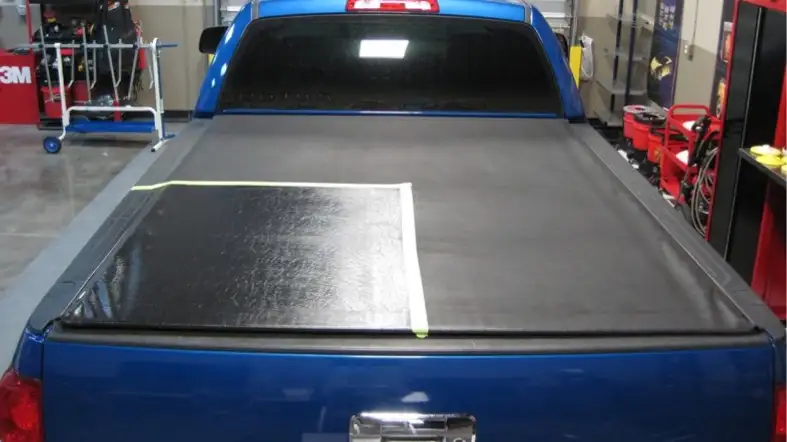Are you looking to add a personal touch to your truck? Have you ever wondered if you can paint a vinyl tonneau cover?
By prepping the surface, choosing the right paint, and applying multiple thin coats, you can transform your tonneau cover.
But how do you choose the right paint? What factors should you consider?
We’ll explore the advantages of painting a vinyl tonneau cover and provide step-by-step instructions and helpful tips to ensure a successful paint job.

Can You Paint A Vinyl Tonneau Cover?
Yes, you can paint a vinyl tonneau cover. However, it’s important to prep the surface properly, use the right type of paint, and apply multiple thin coats for the best results.
Choosing The Right Paint For Vinyl Tonneau Covers
Decide on the Color
Consider the color you want for your tonneau cover. With a wide range of options available, you can find the shade that suits your style and preferences.
Choose the Paint Type
Two main types of paint commonly used for vinyl tonneau covers are acrylic and urethane.
Acrylic paint is budget-friendly but less durable. On the other hand, urethane paint is pricier but offers greater longevity.
Consider the Vinyl Surface
Vinyl tonneau covers are known for their flexibility and ability to withstand various weather conditions.
Look for paint specifically formulated for vinyl surfaces to ensure proper adhesion and long-lasting results.
Opt for Vinyl-Safe Paint
Choose a paint that is labeled as “vinyl-safe” or “vinyl-specific.” These paints are designed to adhere to vinyl surfaces and have the necessary flexibility to expand and contract with the cover, preventing cracking or peeling over time.
Check for UV Protection
Vinyl tonneau covers are often exposed to sunlight, which can cause fading and deterioration.
Look for paint that offers UV protection to help maintain the cover’s color and integrity over the long term.
Select the Right Finish
Consider the desired aesthetic and functionality of your tonneau cover. Matte finishes can provide a sleek and modern look, while glossy finishes offer a polished appearance.
Additionally, some paints may provide additional benefits such as scratch resistance or easy cleaning.
Read Customer Reviews
Before purchasing a specific paint brand or product, take the time to read customer reviews.
Feedback from other users can give you insights into the paint’s performance, durability, and ease of application.
Test a Small Area
Before applying the paint to the entire tonneau cover, test it on a small, inconspicuous area.
This will allow you to assess the color, adhesion, and overall compatibility of the paint with your specific cover.
Factors To Consider Before Painting A Vinyl Tonneau Cover

Type of Vinyl
Not all vinyl is created equal. Some vinyl is more porous than others, making it more difficult to get a good paint job.
If you have a porous vinyl tonneau cover, you may need to sand it before painting to ensure that the paint adheres properly.
Condition of the Vinyl
Repair any cracks, fading, or damage on the tonneau cover before painting.
A smooth and properly prepared surface is essential for paint adherence and durability.
Type of Paint
Choose paint specifically designed for use on vinyl surfaces. Using the wrong paint can result in poor adhesion, fading, or chipping over time.
Application Method
For the best results, use a spray gun to apply paint on the tonneau cover. This ensures even coverage and minimizes brushstrokes or drips.
If a spray gun is unavailable, use a brush or roller and apply thin, even coats.
Curing Process
Allow the paint to cure fully before using the tonneau cover. The curing time can vary depending on the type of paint used, typically taking several days or weeks.
Avoid using the cover until the paint has completely cured.
7 Steps To Paint A Vinyl Tonneau Cover
Gather your materials
You will need the following materials:
- Vinyl paint
- Primer
- Sandpaper
- Spray gun (optional)
- Brush or roller (if using a spray gun)
- Drop cloth
- Safety glasses
- Gloves
Clean the tonneau cover
Use a mild soap and water solution to clean the tonneau cover. Be sure to dry the tonneau cover completely before painting.
Cleaning And Sanding The Tonneau Cover

Before you start painting, it is important to prepare the surface of the tonneau cover. This includes cleaning it thoroughly and sanding it lightly.
Cleaning will remove any dirt, debris, or oil that could interfere with the adhesion of the paint. If the tonneau cover is new and has bed racks installed, you may not need to sand it.
However, if the tonneau cover is old or has been damaged, you will need to sand it to create a rough surface for the paint to adhere to.
Use 180-grit sandpaper and sand the tonneau cover in the direction of the grain.
Apply a primer
A primer will help the paint adhere to the vinyl. Apply the primer according to the manufacturer’s instructions.
Apply the paint
Apply the paint in thin, even coats. Allow each coat to dry completely before applying the next coat.
If you are using a spray gun, hold the gun about 12 inches away from the tonneau cover and move it back and forth in a smooth, even motion.
If you are using a brush or roller, apply the paint in a circular motion.
Apply a clear coat sealant
A clear coat sealant will protect the paint from the elements. Apply the clear coat sealant according to the manufacturer’s instructions.
Allow the paint to cure
The paint will need to cure for several days or even weeks, depending on your paint type. Do not use your tonneau cover until the paint has cured completely.
9 Tips and Techniques for Painting Vinyl Tonneau Covers

- Choose a good quality paint: Good quality paint will be more likely to adhere properly to the vinyl and will last longer.
- Prepare the surface properly: Make sure the surface of the vinyl is clean, dry, and free of any dirt, debris, or oil.
- Apply the paint evenly: Apply the paint in thin, even coats. This will help to prevent the paint from dripping or running.
- Allow the paint to dry completely: Do not use your tonneau cover until the paint has dried completely.
- Protect the paint from the elements: Once it has dried, you can protect it by applying a clear coat sealant.
- Work in a well-ventilated area: Paint fumes can be harmful, so working in a well-ventilated area is important.
- Wear safety glasses and gloves: Paint can be messy, so it is important to wear safety glasses and gloves to protect yourself.
- Apply the paint in a well-lit area: This will help you to see what you are doing and to ensure that the paint is applied evenly.
- Be patient: It takes time to get a good paint job. Don’t expect to get a perfect finish overnight. Be patient and take your time, and you’ll be rewarded with a beautiful, long-lasting paint job.
Advantages Of Painting A Vinyl Tonneau Cover
Personalized Style
By painting your vinyl tonneau cover, you can customize it to match your vehicle’s color or reflect your unique taste. Transform the appearance and make a statement on the road.
Protection from Fading
Vinyl tonneau covers are susceptible to fading due to prolonged exposure to sunlight.
Painting acts as a protective barrier, shielding the cover from UV rays and reducing color fading.
Increased Durability
Painting your tonneau cover adds an extra layer of protection, making it more resistant to scratches, scuffs, and minor damages. It enhances the cover’s durability and extends its lifespan.
Easy Maintenance
A painted tonneau cover is generally easier to maintain than its unpainted counterpart.
It can be cleaned with mild soap and water, just like a painted vehicle, without worrying about damaging the surface.
Weather Resistance
Painting provides an additional level of weather resistance, safeguarding the tonneau cover from rain, snow, and other elements.
This helps prevent water damage and extends the cover’s longevity.
Seamless Integration
A painted tonneau cover can seamlessly integrate with the overall aesthetics of your vehicle, creating a cohesive and polished look.
It adds a finishing touch to the truck’s appearance.
Improved Resale Value
If you plan to sell your vehicle in the future, a painted tonneau cover can enhance its overall appeal and potentially increase its resale value.
It gives potential buyers a favorable impression.
Cost Savings
Instead of purchasing a new tonneau cover, painting the existing one can be a cost-effective alternative.
It allows you to refresh the look without investing in a brand-new cover.
Maintaining a Painted Vinyl Tonneau Cover: Tips and Tricks
Regular Cleaning
Clean your tonneau cover regularly to remove dirt, dust, and other debris that can accumulate over time.
Use a mild soap or vinyl cleaner and a soft cloth or sponge to gently clean the surface. Avoid abrasive cleaners or harsh chemicals that can damage the paint.
Avoid Scratches
Be mindful of sharp objects or rough surfaces that can scratch the painted surface of your tonneau cover.
When loading or unloading items, take care to prevent any contact between the cover and potentially abrasive materials.
Wax or Sealant Application
Applying a wax or sealant on your painted tonneau cover can provide an extra layer of protection.
These products help repel water, minimize fading, and protect against UV rays. Follow the manufacturer’s instructions for the specific product you choose.
Protect from Extreme Temperatures
Extreme temperatures can have a detrimental effect on your tonneau cover’s paint.
During hot summer months, avoid parking your vehicle in direct sunlight for extended periods, as excessive heat can cause the paint to fade or peel.
In cold weather, gently remove any snow or ice from the cover to prevent potential damage.
Inspect for Damage
Regularly inspect your painted tonneau cover for any signs of damage, such as chips, cracks, or peeling paint.
Address any issues promptly by touching up the damaged areas to prevent further deterioration.
Avoid Harsh Chemicals
When cleaning your tonneau cover, avoid using harsh chemicals, solvents, or abrasive cleaners that can strip away the paint or cause discoloration.
Stick to mild soap, water, or products specifically designed for use on painted surfaces.
Storage Considerations
If you store your vehicle for an extended period, consider covering the tonneau cover with a breathable fabric cover.
This will protect it from dust, debris, and potential UV exposure.
Common FAQs About Painting Vinyl Tonneau Covers
Can I Paint Any Type Of Vinyl Tonneau Cover?
Most vinyl tonneau covers can be painted, but it’s important to consider the condition and type of vinyl.
If the cover is cracked, damaged, or made of a porous material, extra preparation may be required for proper paint adhesion.
What Type Of Paint Should I Use For A Vinyl Tonneau Cover?
Use paint specifically designed for vinyl surfaces.
Acrylic or urethane-based paints formulated for vinyl are recommended for durability and adhesion.
Can I Paint My Tonneau Cover Without Sanding It?
Sanding is generally recommended to create a rough surface that allows the paint to adhere properly.
However, if you have a brand-new tonneau cover or one in good condition, sanding may not be necessary.
Can I Use A Brush Or Roller Instead Of A Spray Gun?
While a spray gun provides the best results, you can use a brush or roller if a spray gun is unavailable.
Ensure that you apply the paint in thin, even coats to achieve a smooth finish.
How Many Coats Of Paint Should I Apply?
It’s recommended to apply multiple thin coats of paint rather than a single thick coat.
Typically, two to three coats are sufficient to achieve the desired coverage and appearance.
How Long Does The Paint Need To Cure?
The curing time can vary depending on the type of paint used. It may take several days or even weeks for the paint to fully cure.
Refer to the manufacturer’s instructions for specific guidelines.
Can I Use My Tonneau Cover Immediately After Painting?
It’s crucial to allow the paint to cure completely before using the tonneau cover.
Using it prematurely may result in damage or premature wear of the paint.
Final Words
Painting a vinyl tonneau cover can provide numerous advantages, including personalized style, protection from fading, increased durability, easy maintenance, weather resistance, seamless integration with your vehicle’s aesthetics, improved resale value, cost savings, and more.
You can achieve a successful paint job by considering factors like the type of vinyl, the condition of the cover, the type of paint, the application method, and allowing proper curing time.
Remember to follow maintenance tips and tricks to keep your painted tonneau cover looking its best for years to come.
